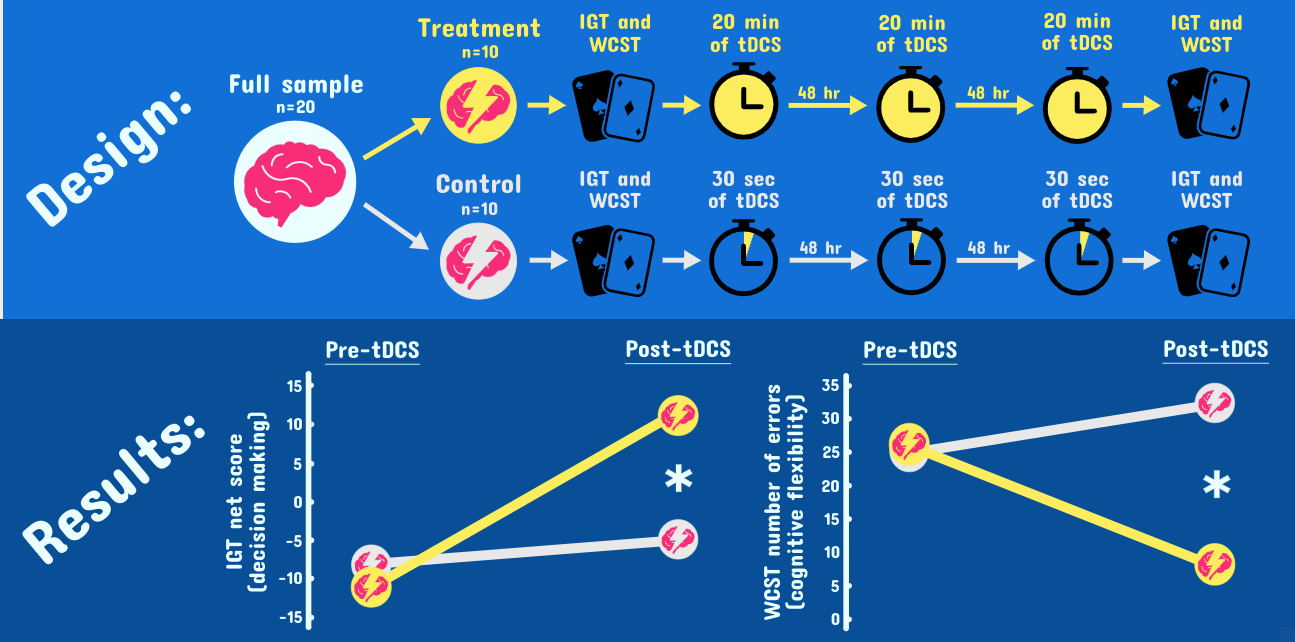The BASIS recently reviewed a study that used transcranial direct current stimulation (tDCS) to change the concentration of the inhibitory neurotransmitter GABA in brains of people being treated for Gambling Disorder (GD). tDCS treatment has also been shown to improve decision making and cognitive flexibility (the ability to switch from thinking about one concept to another), two executive functions that are often diminished in GD. This week, The WAGER reviews a study by Ahmet Zihni Soyata and colleagues that tested the effectiveness of tDCS in enhancing these cognitive capabilities among people with GD.
What was the research question?
Can tDCS affect decision making and cognitive flexibility in people with GD?
What did the researchers do?
The researchers recruited 20 male outpatients being treated for GD at a clinic in Istanbul, Turkey, and divided the sample into a treatment group and a control group. Participants weren’t told which group they were in. All participants attended three tDCS sessions held every other day. During these sessions, those in the treatment group received 20 minutes of active tDCS to the prefrontal cortex, while controls were given a placebo: only 30 seconds of tDCS at the start and none for the remainder of the 20 minutes. As a test of their decision making and cognitive flexibility, participants completed the Iowa Gambling Task (IGT) and Wisconsin Card Sorting Test (WCST) before the first session and after the final session. The researchers used ANOVA tests to compare scores between groups.
What did they find?
At baseline, both groups performed similarly on the two tests. But, after the tDCS sessions, participants in the treatment condition performed significantly better on average than participants in the control condition on both the IGT and the WCST (see figure). Because this was a controlled experiment, these results indicate that active tDCS enhanced these executive functions in the sample.
 Figure. Top: The experimental design. Bottom: Mean IGT and WCST performance by both groups, before and after tDCS sessions. Asterisks represent statistically significant differences. Adapted from Zihni Soyata et al., 2018. Click image to enlarge.
Figure. Top: The experimental design. Bottom: Mean IGT and WCST performance by both groups, before and after tDCS sessions. Asterisks represent statistically significant differences. Adapted from Zihni Soyata et al., 2018. Click image to enlarge.
Why do these findings matter?
Dropout and relapse rates are high among GD patients, but enhancing decision making and cognitive flexibility in this population using tDCS could be used to reinforce more traditional forms of treatment, and to help patients stay in treatment and resist future urges to gamble excessively. However, tDCS treatment won’t be here for a while. More research is needed to test its short-term and long-term effects, as well as the effects of more sessions, before this treatment method can be widely adopted.
Every study has limitations. What are the limitations in this study?
The authors recruited participants from a clinic, so these results might not apply to non-treatment seekers who may be more impulsive. Additionally, no women were included in this study. tDCS could have a different effect on women in this cognitive domain, as they perform differently than men on the Iowa Gambling Task. Lastly, the study only examined 20 people; small sample sizes decrease statistical power.
For more information:
If you think that you or someone you know might have a gambling problem, visit the National Council on Problem Gambling for screening tools and resources. For additional resources, visit our addiction resources page.
— Jamie Juviler
What do you think? Please use the comment link below to provide feedback on this article.




